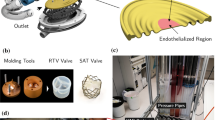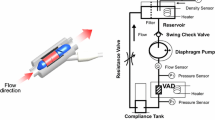Abstract
A pneumatic driven ventricular assist device (VAD) is not only designed for short-term usage of a “bridge to recovery” (BTR) in cardiac function recovery, but also developed to apply as a “bridge to transplantation” (BTT) for cardiac transplant. However, in the latter, the VAD must be exchanged before its expiries of guarantee. In this research, the authors have investigated the connector’s strength between connector and cannula, and safety during the VAD exchange.
Preview
Unable to display preview. Download preview PDF.
Similar content being viewed by others
References
Matsumiya, G.: Artificial Heart (Clinical ). J. Artificial Organs 33(3), 167–170
Takano, H., Nakatani, T.: Ventricular assist system in Japan with Toyobo pump and Zeon pump. Am. Thorac. Surg. 55, 317–322 (1996)
Matsuda, H., Matsumiya, G.: Current status of left ventricular assist devices the role in bridge to heart transplantation and future perspectives. J. Artif. Organs 6, 157–161 (2003)
Muller, J., et al.: Weaning from mechanical cardiac support in patients with idiopathic dilated cardiomyopathy. Circulation 96, 542–548 (1997)
Author information
Authors and Affiliations
Editor information
Rights and permissions
Copyright information
© 2007 Springer-Verlag Berlin Heidelberg
About this paper
Cite this paper
Tanaka, T. et al. (2007). Tensile Test to Ensure a Safety of Cannula Connection in Clinical Ventricular Assist Device (VAD). In: Li, K., Li, X., Irwin, G.W., He, G. (eds) Life System Modeling and Simulation. LSMS 2007. Lecture Notes in Computer Science(), vol 4689. Springer, Berlin, Heidelberg. https://doi.org/10.1007/978-3-540-74771-0_62
Download citation
DOI: https://doi.org/10.1007/978-3-540-74771-0_62
Publisher Name: Springer, Berlin, Heidelberg
Print ISBN: 978-3-540-74770-3
Online ISBN: 978-3-540-74771-0
eBook Packages: Computer ScienceComputer Science (R0)




